On the 9th of November 1888, after an absence of over a month, Jack the Ripper returned to the East End Streets and carried out his most gruesome and disturbing crime to date – the murder of Mary Kelly.
Mary occupied a single room in Miller’s Court, a turning situated off one of the East End’s most notorious thoroughfares, Dorset Street, Spitalfields.
NEWSPAPER ACCOUNTS
Over the course of the subsequent weekend, the newspapers published lurid details of what had, evidently, been an horrific atrocity and, in their desperation to out-sensationalise each other with the most up to date news, they published accounts, some of which contained several inaccuracies which have since found their way into ripper lore.
The following account appeared in Lloyd’s Weekly Newspaper on Sunday 11th November 1888. I have reproduced the article as it appeared but have commented on the mistakes that were made.
The article’s headlines informed readers:-
ANOTHER WHITECHAPEL HORROR
MURDER OF A WOMAN IN HER OWN ROOM
MORE REVOLTING MUTILATION THAN EVER
The article read:-
“On Friday another addition was made to the series of horrible crimes that has created a panic in the East-end of London for many weeks past, and has sent a thrill of horror through the country at large.
As in the previous cases, the scene of the tragedy lies in the district of Whitechapel, within almost a stone’s throw of Hanbury-street, where the unfortunate woman Nicholls [they got the wrong victim here as the Hanbury Street victim was Annie Chapman] was so brutally put to death.
The victim occupied a single room on the ground door of a small house in Miller’s-court, Dorset-street, a thoroughfare running out of Commercial-street, nearly opposite Spitalfields church.
She had lived here for 10 months with a man who passed as her husband, and was known as Mary Jane Kelly. At the beginning of the week the couple quarrelled, and the man left her.
Subsequently the woman was seen about the streets with other men, and as late as Thursday midnight, or a little after, she is known to have been alive and well.
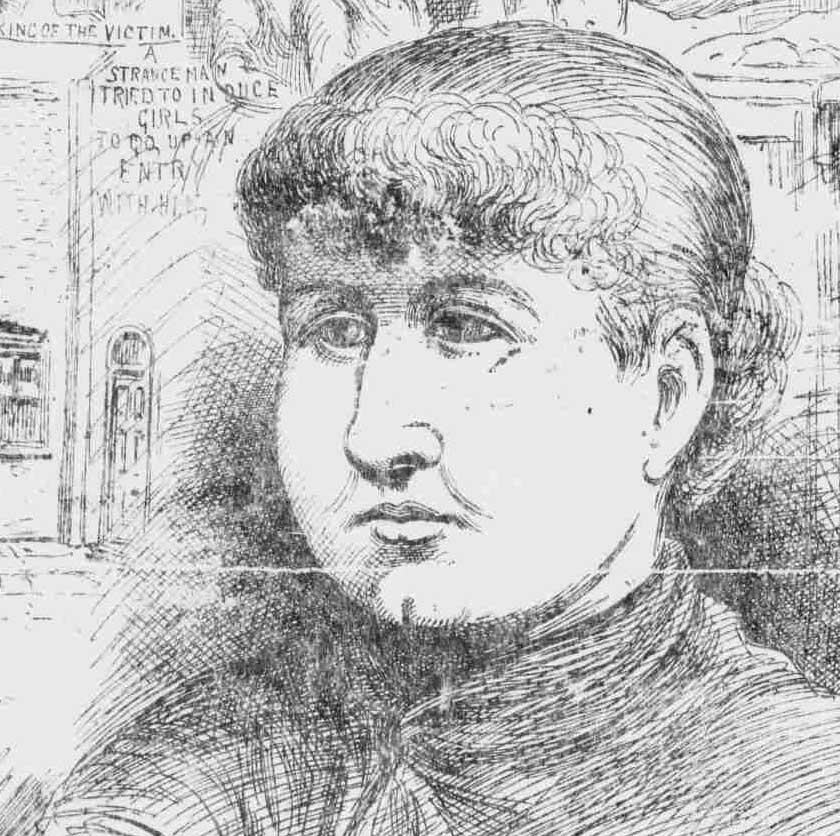
HOW THE BODY WAS FOUND
At a quarter to eleven o’clock on the following (Friday) morning Mr. McCarthy, the landlord, sent a man to ask for some rent, as Kelly had got into arrears.
The man knocked at the door several times, and failing to obtain any answer he went to the window which looks into the court, and peering in saw that there was blood about the bed.
In a state of alarm be ran back to his master, whose shop stands at the entrance to the court.
Mr. McCarthy at once returned with him, and finding a corner of one of the window panes broken pushed in his fingers far enough to thrust aside the blind.
He then saw sufficient to know that a tragedy had been committed, and exclaimed “This is another Whitechapel murder.”
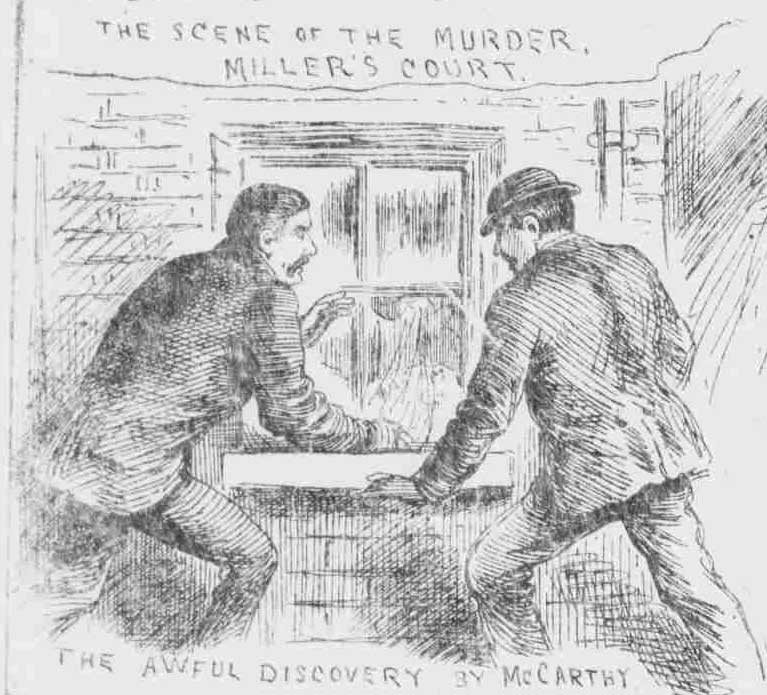
THE POLICE SENT FOR
The man was immediately sent to the Commercial-street police-station, and enjoined not to tell any of the neighbours what bad been discovered.
Inspector Beck, H division, who was in charge of the station at the time, accompanied the man back, and on finding that a murder had been committed at once sent for assistance.

Dr. Phillips, the divisional surgeon of police, and Superintendent Arnold were also sent for.
During this time the door had not been touched.
On the arrival of Superintendent Arnold he caused a telegram to be sent to Scotland-yard announcing what had happened.
THE SICKENING SIGHT
Mr. Arnold entered by the window, and a horrible and sickening sight presented itself.
The poor woman lay on her back on the bed, entirely naked. Her throat was cut from ear to ear, right down to the spinal column. The ears and nose had been cut clean off.
The breasts had also been cleanly cut off and placed on a table which was by the side of the bed.
The stomach and abdomen had been ripped open, while the face was hacked about, so that the features of the poor creature were beyond all recognition.
The kidneys and heart had also been removed from the body, and placed on the table by the side of the breasts.
The liver had likewise been removed, and laid on the right thigh.
The lower portion of the body and the uterus had been cut out.
One hand had been placed in the empty abdomen.
The thighs had been cut and slashed about so as to leave the bones visible.
A more horrible or sickening sight could not possibly be imagined.
The clothes of the woman were lying by the side of the bed, as though they had been taken off and laid down in the ordinary manner.
Superintendent Arnold had the door of the room forced, as the murderer had left it securely fastened, and removed the key.

A DESCRIPTION OF HER ROOM
It was a wretchedly-furnished apartment, about 12 feet long by eight feet wide, there being only an old painted wood bedstead, two old tables, and a chair in it.
The bedclothes had been turned down, and this was probably done by the murderer after he had cut his victim’s throat.
There was no appearance of a struggle having taken place, and, although a careful search of the room was made, no knife or instrument of any kind was found.
The appearance of the ashes in the grate, however, gave rise to the suspicion that something had been burnt.
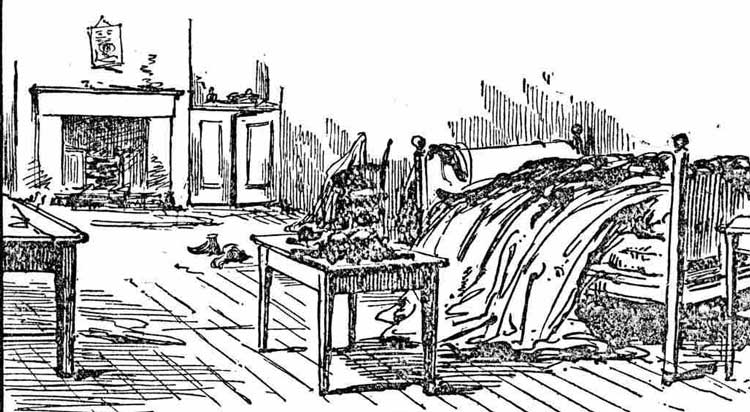
THE DOCTORS AND THE POLICE
Dr. Phillips, on his arrival, carefully examined the body of the dead woman, and later on again made a second examination in company with Dr. Bond, from Westminster; Dr. Gordon Brown, from the City; Dr. Duke, from Spitalfields ; and Dr. Phillips’s assistant.
Mr. Anderson, the new Commissioner of Police [Sir Charles Warren had resigned as Commissioner, however, Dr. Anderson was most certainly not the new Commissioner as one had not yet been appointed]; Detective-inspectors Reid and Abberline (Scotland-yard), Chief-inspector West (H division), and other officers were quickly on the spot.
Dr. J. R. Gabe, of Mecklenburg-square, saw the body, but, in reply to a question put to him, he declined to give any details. He merely said that he had seen a great deal in dissecting-rooms, but that he had never, in all his life, seen such a horrible sight as the murdered woman presented.
THE BODY PHOTOGRAPHED
While the medical examination was being made a photographer, who had been sent for, arrived and took photographs of the body, the organs, the room, and its contents.

REMOVED IN A COARSE COFFIN
The mutilated remains were then placed in a coarse coffin, which had apparently been used on many previous occasions for the conveyance of the dead, and which was partially covered with a coarse canvas cloth.
The straps of the coffin were sealed.
The coffin was conveyed in a one horse ordinary furniture van, and was escorted by several constables, under Serjeant Betham.
A large mob followed the van to the Shoreditch mortuary, where a crowd was waiting to see the coffin transferred to the building.
The photographer removed his camera from the premises at about half-past four o’clock, and shortly afterwards a detective officer carried away from the house a pail, with which he left in a four-wheel cab.
The pail was covered with a newspaper, and was stated to contain portions of the woman’s body.
It was taken to the house of Dr. Phillips, 2, Spital-square.
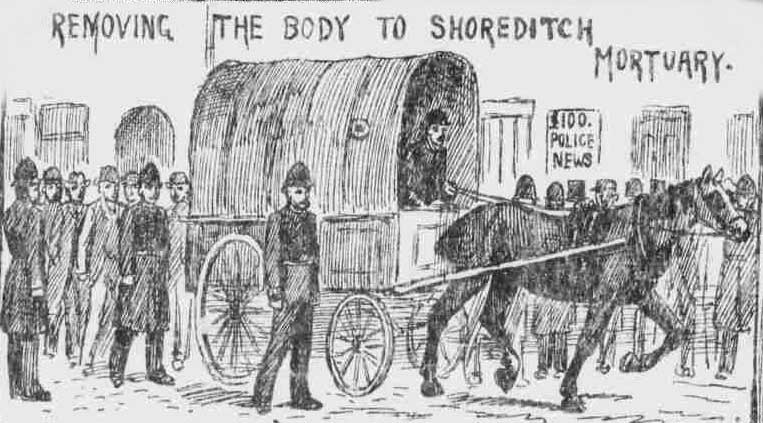
NO ONE ALLOWED IN OR OUT
The window of the room where the crime was committed was boarded up, and a padlock put on the door.
With the arrival of the police and doctors news of the tragedy quickly spread, and crowds began to gather.
Miller’s-court was blockaded, the police refusing either egress or ingress to the inhabitants.
The traffic in Dorset-street was also regulated.
The refusal of the police to allow anyone to enter or to leave Miller’s-court was connected with an intention to put the bloodhounds on the track of the murderer, and it was feared that the scent would be seriously interfered with, if not completely destroyed, if indiscriminate traffic were allowed.
The bloodhounds were asked for immediately the discovery was made; but they did not appear – the reason being, it is said, that during recent trials in Surrey the animals bolted and were not recovered. [This is an oft-trotted out fallacy that simply wasn’t true, the Metropolitan Police had refused to underwrite the cost of the bloodhounds].
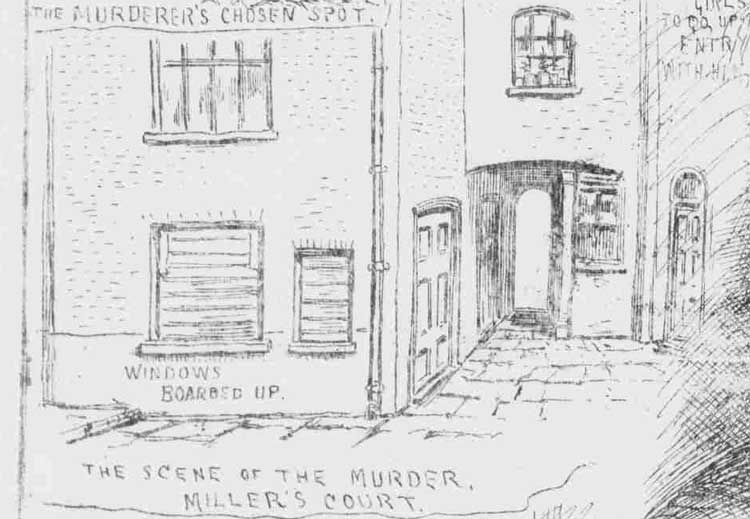
THE LANDLORD’S STATEMENT
Mr. John McCarthy, the owner of the houses in Miller’s-court, who keeps a general shop at 27, Dorset-street, says Kelly had lodged with him 10 months, the man Barnett having passed as her husband and by her name.
It was during their quarrel before separating that the window of the room. was broken.
They paid 4s. a week rent, but it had got into arrears to the amount of 29s.
It was owing to this fact that he sent his man, Harry Bowyer, to ask if she could pay any money.
After describing the horrible discovery and his sending for the police Mr. McCarthy went on to say that his man brought back Inspector Beck, who looked through the window as he had done.
He then dispatched a telegram to Superintendent Arnold, but before Superintendent Arnold arrived Inspector Abberline came and gave orders that no one should be allowed to enter or leave the court.
The inspector waited a little while, and then sent a telegram to Sir Charles Warren to bring the bloodhounds, so as to trace the murderer if possible.
So soon as Superintendent Arnold arrived he gave instructions for the door to be burst open. I at once forced the door with a pickaxe, and we entered the room.
MORE LIKE THE WORK OF A DEVIL
The sight we saw I cannot drive away from my mind. It looked more like the work of a devil than of a man.
The poor woman’s body was lying on the bed, undressed.
She had been completely disembowelled, and her entrails had been taken out and placed on the table.
It was those that I had seen when I looked through the window and took to be lumps of flesh.
The woman’s nose had been cut off, and her face gashed and mutilated so that she was quite beyond recognition.
Both her breasts too had been cut clean away and placed by the side of her liver, and other entrails on the table.
I had heard a great deal about the Whitechapel murders, but I declare to God I had never expected to see such a sight as this.
The body was, of course, covered with blood, and so was the bed.
The whole scene is more than I can describe. I hope I may never see such a sight again.
It is most extraordinary that nothing should have been heard by the neighbours, as there are people passing backwards and forwards at all hours of the night, but no one heard as much as a scream.
A woman heard Kelly singing “Sweet Violets” at one o’clock this (Friday) morning.
So up to that time, at all events, she was alive and well. So far as I can ascertain no one saw her take a man into the house with her last night.
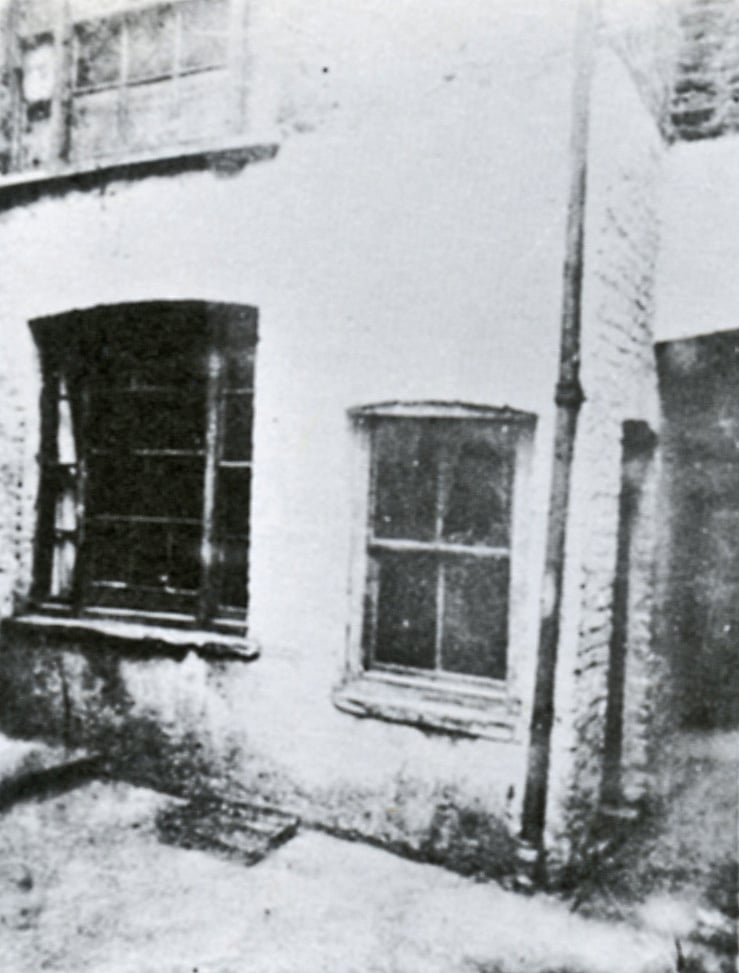
CAREER OF THE VICTIM
Joseph Barnett, the man who lived with the deceased woman Kelly as her husband until four days before the murder, made the following statement to a reporter:-
“I first met the deceased last Easter twelvemonth, and lived with her from that time until last Tuesday week.
I was in decent work in Billingsgate market when I first met her, and we lived along quite comfortably.
She was 22 years of age, fresh looking, and well behaved, though she had been walking the streets some three years previously.
She told me that her maiden name was Marie Jeannette Kelly, and that she was born in Limerick.
Her parents, who were fairly well off, removed when she was a child to Wales, and they lived in Carmarthenshire.
When she was but little over 16 years of age she married a collier, but I do not remember his name. He was killed in an explosion in the mine, and then Marie went to Cardiff with her cousin, living as a prostitute.
Thence she went to France, but remained only a short time.
Afterwards she lived in a fashionable house of ill-fame in the West-end of London, but drifted from the West-end to the East-end, where she took lodgings in Pennington-street.
Her father came from Wales and tried to find her there, but hearing from her companions that he was looking for her, Marie kept out of the way.
A brother in the 2nd batt. Scots Guards came to see her once, but beyond that she saw none of her relations, nor did she correspond with them.
When she was in Pennington-street a man named Morgan-stone lived with her, and a man named Fleming passed as her husband.
She lived with me, first of all, in George-street, then in Paternoster-court, Dorset-street; but we were ejected from our lodgings there because we went on a drunk, and did not pay our rent.
We took lodgings afterwards in Brick- lane, and finally, about four months ago, in Miller’s-court, where the murder occurred.
We lived comfortably until Marie allowed a prostitute named Julia to sleep in the same room. I objected; and as Mrs. Harvey afterwards came and stayed there, I left her, and took lodgings elsewhere.
I told her that I would come back if she would go and live somewhere else.
I used to call there nearly every day, and if I had any money I used to give her some.
I last saw her alive at 7.30 on Thursday night.
I stopped about a quarter of an hour, and told her I had no money.
Next day I heard there had been a murder in Miller’s-court, and on my way there I met my sister’s brother-in-law, and he told me it was Marie.
I went to the court and there saw the police inspector, and told him who I was, and where I had been the previous night.
They kept me about four hours, examined my clothes for blood stains, and finally, finding the account of myself to be correct, let me go free.
Marie never went on the streets when she lived with me. She would never have gone wrong again, and I should never have left, if it had not been for the prostitutes stopping in the house. She only let them in the house because she was good-hearted, and did not like to refuse them shelter on cold bitter nights.”
From another source it appears that the collier whom the deceased married was named Davies.

LIZZIE ALBROOK’S STATEMENT
Lizzie Albrook, a young woman of 20, who resides in Miller’s-court and works at a lodging-house in Dorset-street, also made the following statement:-
“I knew Mary Jane Kelly very well, as we were near neighbours.
The last time I saw her was on Thursday night, about eight o’clock, when I left her in her room with Joe Barnett, who had been living with her.
About the last thing she said was, “Whatever you do don’t you do wrong and turn out as I have.”
She had often spoken to the in this way, and warned me against going on the streets as she had done.
She told me, too, she was heartily sick of the life she was leading, and wished she had money enough to go back to Ireland, where her people lived.
I don’t believe she would have gone out as she did if she had not been obliged to do so in order to keep herself from starvation.
She had talked to me about her friends several times, and on one occasion told me she had a female relation in London who was on the stage.”
SHE HAD NO CHILD
The pathetic story told in many papers of the murdered woman’s solicitude for her little son is entirely without foundation. Kelly had no child. The only boy of whom anything is known belonged to a woman with whom she was very friendly, and who stayed with her on several occasions.
WHEN KELLY WAS LAST SEEN.
There is considerable conflict of testimony as to when the victim was last seen alive.
Those who aver that she went out between eight and nine of Friday morning are very positive in their statements; but they are not credited by the landlord McCarthy, and we have reason to believe that at the inquest on Monday the medical evidence will tend to disprove them.
Among the various strange statements made by neighbours are the following :-
I KNOW MORE THAN YOU
A Mrs. Paumier, a young woman who sells roasted chestnuts at the corner of Widegate-street, a narrow thoroughfare, about two minutes’ walk from the scene of the murder, told a reporter a remarkable story.
She says that about 12 o’clock (noon) on Friday, a man, dressed like a gentleman, came to her and said, “I suppose you have heard about the murder in Dorset-street.”
She replied that she had, and the man grinned and said, “I know more about it than you.”
He then stared into her face, and went away down Sandes-row, another narrow thoroughfare which cuts across Widegate-street.
When he had got some way off, however, he looked back as if to see whether she was watching him, and then vanished.
Mrs. Paumier says that the man had a black moustache, was about 5ft. 6in. high, and wore a black silk hat, a black coat, and speckled trousers. He carried a black shiny bag about a foot in depth, and a foot and a half in length.
Mrs. Paumier states further that the same man accosted three young unfortunates in Dorset-street on Thursday night, and they chaffed him, and asked him what he had in the bag, and he replied, “Something that the ladies don’t like.”
Mrs. Paumier told her story with every appearance of truthfulness.
MAURICE LEWIS’S STATEMENT
Maurice Lewis, a tailor, living in Dorset-street, stated that he had known the deceased woman for the last five years.
Her name was Mary Jane Kelly.
She was short, stout, and dark ; and stood about 5ft. 3in.
He saw her on the previous (Thursday) night, between 10 and 11, at the Horn of Plenty, in Dorset-street.
She was drinking with some women and also with “Dan,” a man selling oranges in Billingsgate and Spitaltields markets, with whom she lived up till as recently as a fortnight ago.
He knew her as a woman of the town.
One of the women whom he saw with her was known as Julia.
To his knowledge she went home overnight with a man.
He seemed to be respectably dressed. Whether or not the man remained all night he could not say.
Soon after 10 o’clock in the morning he was playing with others at pitch and toss in McCarthy’s-court, when he heard a lad call out “copper,” and he and his companions rushed away and entered a beer-house at the corner of Dorset-street, known as Ringer’s. [This was the local nickname for the Britannia, which stood at the corner of Dorset Street and Commercial Street].
He was positive that on going in he saw Mary Jane Kelly drinking with some other people, but is not certain whether there was a man amongst them.
He went home to Dorset-street on leaving the house, and about half-an-hour afterwards heard that Kelly had been found in her room murdered.
It would then be close upon 11 o’clock.
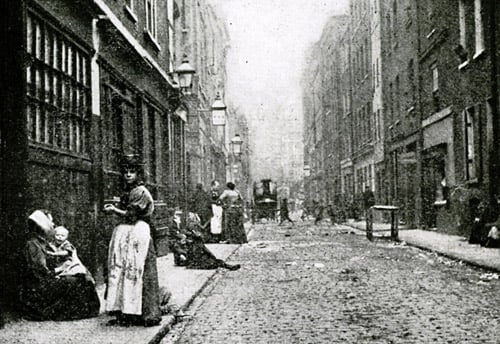
MRS MAXWELL’S SIGHTING
Mrs. Maxwell, the wife of the deputy of a lodging-house in Dorset-street, situated just opposite the court where Mary Kelly lived, said to a reporter:-
“I assist my husband in his duties, but we live next door, at 26, Dorset-street.
We stay up all night, and yesterday (Friday) morning, as I was going home, carrying my lantern and other things with me, I saw the woman Kelly standing at the entrance of the court.
It was then about half-past eight o’clock, and as it was unusual for her to be seen about at that hour.
I said to her, “Hallo, what are you doing up so early ?”
She said: “Oh, I’m very bad this morning. I have had the horrors. I have been drinking so much lately.”
I said to her, “Why don’t you go and have half a pint of beer ? It will put you right.”
She replied, “I’ve just had one; but I am so bad I couldn’t keep it down.”
I didn’t know then that she had separated from the man she had been living with, and I thought he had been “paying” her.
I then went out in the direction of Bishopsgate to do some errands, and on my return I saw Kelly standing outside the public-house talking to a man.
That was the last I saw of her.”
AN EXTRAORDINARY TALE
A woman named Kennedy, who was on the night of the murder staying with her parents at a house situate in the court immediately opposite the room in which the body of Mary Kelly was found, tells a more extraordinary tale.
She states that about three o’clock on Friday morning she entered Dorset-street, and noticed three persons at the corner of the street, near the Britannia, public-house.
There was a man – a young man, respectably dressed, and with a dark moustache – talking to a woman whom she did not know, and also a female poorly clad and without any headgear.
The man and woman appeared to be the worse for liquor, and she heard the man ask, “Are you coming?”, whereupon the woman, who appeared to be obstinate, turned in an opposite direction to which the man apparently wished her to go.
Mrs. Kennedy went on her way after witnessing this, and nothing unusual occurred until about half-an-hour later.
She states that she did not retire to rest immediately she reached her parents’ abode, but sat up, and between half-past three and a quarter to four she heard a cry of “Murder !” in a woman’s voice proceed from the direction in which Mary Kelly’s room was situated.
As the cry was not repeated she took no further notice of the circumstance until the morning, when she found the police in possession of the place.
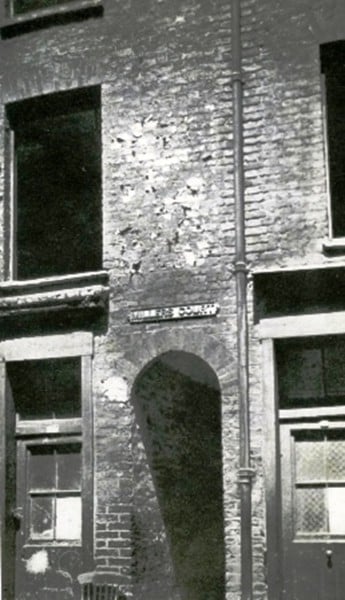
THE SCENE OF THE MURDER.
Dorset-street is a fairly wide thoroughfare, occupied almost entirely by common lodging houses, one immediately opposite the entrance to Miller’s-court accommodating some 300 men.
The court, containing six two-roomed dwellings of the poorest and meanest description, with whitewashed fronts, forms a cul de sac.
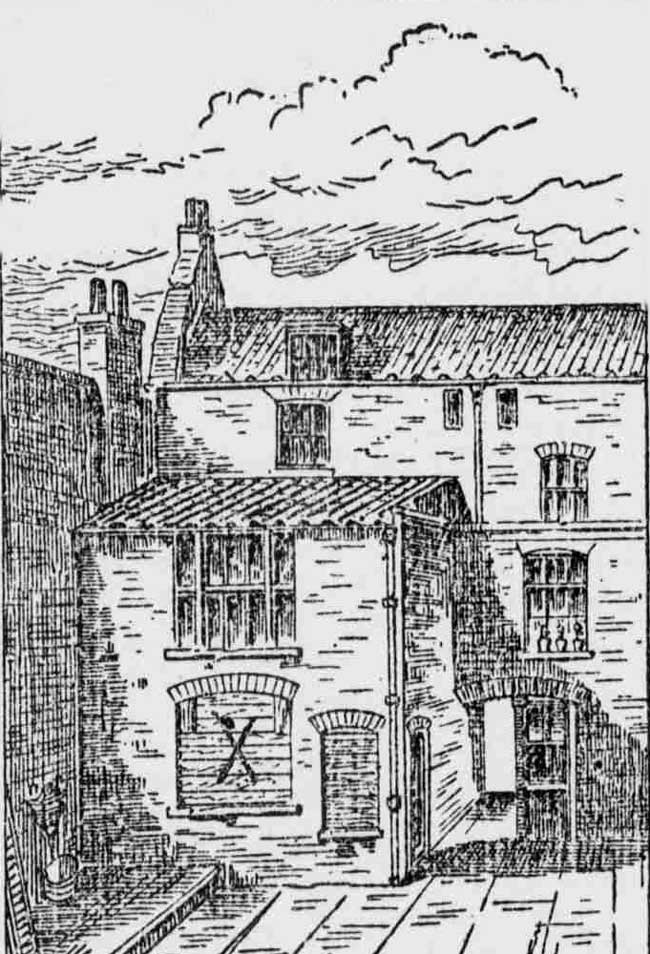
THE BOARDED UP WINDOW
The boarded-up window of the room in winch the murder was committed is marked in the above sketch with an X.
It looks into the court, and the room is entered by a door at the end of the covered passage, not more than a yard wide, which runs between 26 and 27, Dorset-street, and forms the entrance to Miller’s-court.
The room, however, is really the back parlour of 26, Dorset-street, the front shop being partitioned off, and used for the storage of barrows, &c.
This was formerly left open, and poor persons often took shelter there for the night; but when the Whitechapel murders caused so much alarm the police thought the spot offered a temptation to the murderer, and so the front was securely boarded up.
Although the window was open to the observation of any of the inmates of the court, the door was some distance from any other, and afforded the utmost facility for an easy escape.”

COMING TO TERMS WITH THE MURDER
And thus, at the end of the weekend, the people of the East End settled down as best they could knowing that the Whitechapel Murderer was still on the loose.
However, what none of them could have known as they attempted to come to terms with the horror of what had occurred in Miller’s Court was that, with the murder of Mary Kelly, Jack the Ripper’s murderous reign of terror had reached a bloody and gruesome climax.
